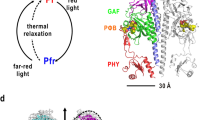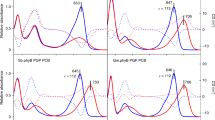Abstract
PHYTOCHROME is the photoreceptor for many light-mediated developmental responses in plants1. This chromoprotein, considered a dimer of apparently identical 120,000-dalton subunits (undegraded phytochrome)2,3, has often been purified from oats as a monomeric 60,000-dalton degradation product (degraded phytochrome)2,3 because of its susceptibility to proteases present in crude extracts3. Degraded phytochrome is relatively resistant to further proteolysis and has almost the same photochemical properties as undegraded phytochrome2. Immunochemical evidence4 indicates that undegraded phytochrome is asymmetric, possessing extensive primary structure not found in degraded phytochrome. In contrast, recent peptide-map data, obtained by a fluorescence procedure, have led to the conclusion that undegraded phytochrome is symmetric, being composed of two nearly identical halves, each half being equivalent to the 60,000-dalton, photoreversible degradation product5. We present here autoradiographic tryptic digest maps of iodinated degraded and undegraded phytochrome from etiolated oat (Avena sativa L., cv. Garry) seedlings that offer additional evidence concerning asymmetry in the primary structure of undegraded phytochrome.
This is a preview of subscription content, access via your institution
Access options
Subscribe to this journal
Receive 51 print issues and online access
$199.00 per year
only $3.90 per issue
Buy this article
- Purchase on Springer Link
- Instant access to full article PDF
Prices may be subject to local taxes which are calculated during checkout
Similar content being viewed by others
References
Smith, H. Phytochrome and Photomorphogenesis (McGraw-Hill, London, 1975).
Pratt, L. H. Photochem. Photobiol. 27, 81–105 (1978).
Briggs, W. R. & Rice, H. V. A. Rev. Pl. Physiol. 23, 293–334 (1972).
Cundiff, S. C. & Pratt, L. H. Pl. Physiol. 51, 210–213 (1973); Pl. Physiol. 55, 207–211 (1975); Pl. Physiol. 55, 212–217 (1975).
Stoker, B. M., Roux, S. J. & Brown, W. E. Nature 271, 180–182 (1978).
Pratt, L. H. Pl. Physiol. 51, 203–209 (1973).
Rice, H. V., Briggs, W. R. & Jackson-White, C. J. Pl. Physiol. 51, 917–926 (1973).
Weber, K. & Osborn, M. J. biol. Chem. 244, 4406–4412 (1969).
Elder, J. H., Pickett, R. A. II, Hampton, J. & Lerner, R. A. J. biol. Chem. 252, 6510–6515 (1977).
Konigsburg, W. H. & Steinman, H. M. in The Proteins 3rd edn, Vol. III (eds Neurath, H., Hill, R. L. & Boeder, C. L.) 15 (Academic, New York, 1977).
Krohn, K. A., Knight, L. C., Harwig, J. F. & Welch, M. J. Biochim biophys. Acta 490, 497–505 (1977).
Keil, B. in The Enzymes 3rd edn, Vol. 3 (ed. Boyer, P.) 249–275 (Academic, New York, 1971).
Roitt, I. M. Essential Immunology 2nd edn, 4 (Blackwell, Oxford, 1974).
Author information
Authors and Affiliations
Rights and permissions
About this article
Cite this article
KIDD, G., HUNT, R., BOESHORE, M. et al. Asymmetry in the primary structure of undegraded phytochrome. Nature 276, 733–735 (1978). https://doi.org/10.1038/276733a0
Received:
Accepted:
Issue Date:
DOI: https://doi.org/10.1038/276733a0
This article is cited by
Comments
By submitting a comment you agree to abide by our Terms and Community Guidelines. If you find something abusive or that does not comply with our terms or guidelines please flag it as inappropriate.



